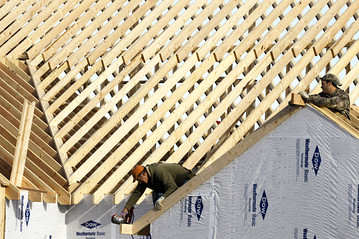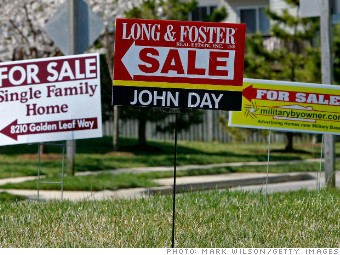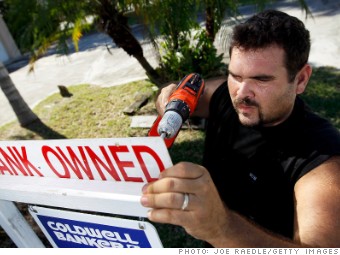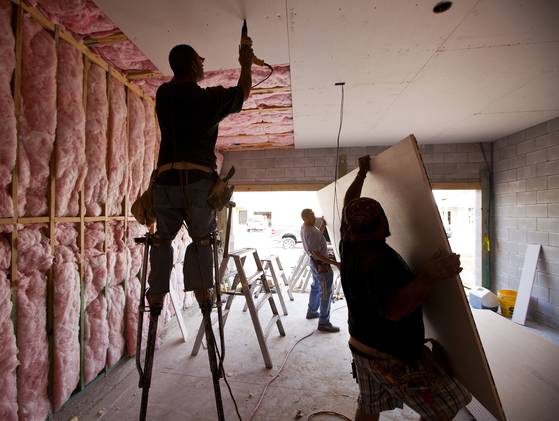At Builders’ Show, an Upbeat Forecast for Housing
by Dawn Wotapka-WSJ Blogs

Leading housing economists told builders Tuesday that the housing market has struck the long-awaited bottom and is expected to show robust gains, particularly in 2014.
Builders are expected to start construction on 650,000 single-family homes in 2013, representing an increase of nearly 22% from the prior year, followed by a 30% increase to 844,000 in 2014, said David Crowe, the National Association of Home Builders’ chief economist, during a presentation at the International Builders’ Show in Las Vegas.
Starts of multifamily housing, which have spiked to meet a seemingly insatiable demand for rental units following the housing crash, should increase 22% to nearly 300,000 this year, followed by a 6% gain in 2014. But construction of multifamily units is expected to slow from the strong pace of recent years.
Sales and prices are also expected to rise.
Frank Nothaft Freddie Mac’s chief economist, expects residential sales to increase 8% in 2013, boosted by consumers taking advantage of mortgage rates that should remain below 4% for the year.
Home prices could rise between 2% and 3% in 2013, showing that the downward spiral in prices has ended in most markets. “We’re moving in the right direction,” Mr. Nothaft said in an interview, adding that the market is a few years away from returning to a normal pace of activity.
The National Association of Home Builders’ Improving Markets Index showed 242 healing markets in January, up from 12 when the index started in September of 2011. “My optimism is more solid,” Mr. Crowe said. “We’re seeing these gains across a larger number of markets.”
To be sure, concerns loom. Nearly 80% of builders said their most significant concern is the rising cost of building materials, followed by gridlock and uncertainty in Washington, which could make consumers jittery about buying a home.
Other obstacles include the mediocre jobs market and ongoing issues with home appraisals. The difficulty of qualifying for a mortgage continues to keep plenty of would be buyers out of the market, according to David Berson, chief economist with Nationwide Insurance. “Underwriting criteria that are too tough won’t stop the housing market from getting better but it puts a cap on how far it can go,” he said. “Lenders and regulators have become hyper-sensitive about credit risk.”
Five Facts on the Housing Construction Rebound
by Nick Timiraos, Wall Street Journal

Housing construction ended 2012 on a high note, with new units in December rising 12% from November and 37% from a year ago.
The boom in construction shouldn’t be too surprising, given that permits have risen in recent months and that builder confidence has risen. But it is a clear indication that rising household formation and sharp drops in the number of homes for sale are finally benefitting home builders. Five facts help to put today’s report in context:
1. Multifamily housing starts accounted for the highest share of overall housing starts, at 30%, since 1986, when the U.S. experienced overbuilding in the apartment sector. Of course, back then, there were more than double the number of apartments being constructed. (The multifamily share of construction fell to just 15% in 2005, the peak year of new home construction).
2. Multifamily construction in 2012 was more than double the rate of 2009 and 2010 combined, at 233,400 units. But that was still lower than any year between 1995 and 2008.
3. Single-family housing starts ended the year at 535,500, which is the fourth lowest since record keeping began in 1959, but a hefty 24% above last year’s level, which was the lowest on record. In other words, construction is very low, but it is beginning to pick up the pace.
4. December’s rate of new construction, which hit a seasonally adjusted annual level of 954,000 total units and 616,000 single-family units, stood at the highest level in 4½ years. Still, the single-family starts figure was below that of every month between June 1982 and June 2008.
5. New housing unit completions are up only 11% from 2011, notes Jed Kolko, chief economist at Trulia, which is below the 28% gain in new construction starts. “That means many of the homes started in 2012 won’t be completed until 2013,” he writes.
5 Signs to Watch for Housing in 2013
by Nin-Hai Tseng at Fortune Magazine
We watched for more home sales and rising prices in 2012. Here’s our housing market predictions for next year.

Buying Gets Less Affordable:
The bust of the housing market five years ago created one of the cheapest times to buy. Across many parts of the U.S., even in some of the priciest markets including New York and Honolulu, it has become cheaper to purchase a home than rent, according to Trulia’s Rent vs Buy report. Record-low interest rates on mortgages have also made buying more affordable.
That’s changing, however. In 2012, prices hit bottom. Finally! While that tells us the market is healing, it could also mean buying will be less affordable in 2013. Asking prices for homes for sale rose 3.8% in November from a year earlier — one of the biggest gains since the housing market crashed in 2007. While rents nationwide are still rising faster than home prices, the trend has reversed in 14 of Trulia’s 25 biggest rental markets including Denver, Seattle and San Francisco.

Watch for Rising Jobs, Not Rising Prices:
Most of us watched home prices to gauge the health of the housing market. That was so 2012, however. Just because prices are rising doesn’t necessarily mean the industry is doing any better. Next year, a better pulse of the market will be the rate of jobs growth, says Jed Kolko, chief economist with Trulia.
Cities like Las Vegas, Miami and Phoenix have seen home prices surge, but it’s uncertain how long that could last. Prices have risen, partly because they fell so much and also because many homes are still undergoing the foreclosure process. They’re also cities in states with some of the highest rates of unemployment, which ties closely to how well people will be positioned to buy.

Delinquencies Fall (Very Slowly):
The troubled housing market was marked by record foreclosures, which is why economists closely watch the rate at which homeowners are late on their payments — they’re a precursor to foreclosures. Nationwide, the delinquency rate on mortgages peaked during the last three months of 2009 at 6.89%, after rising 12 quarters in a row from 1.49% in 2006.
As of the latest quarter, the delinquency rate dropped to 5.41%. And for 2013, it’s expected to continue dropping — albeit, slowly to around 2%. Much of the late payments are made up of existing borrowers more than a year late on their payments, as opposed to new borrowers following stricter lending standards. Some of the biggest declines are expected in Nevada, Minnesota, California and Arizona.

Record Low Interest Rates:
Cheap money has certainly helped the housing market recover. For the past few years, average interest rates on 30-year-fixed mortgages fell to new lows. With December remaining, rates this year averaged 3.68%, lower than the average 4.45% for 2011 and 4.69% in 2010.
To be sure, rates can’t stay low forever. Which is why some have worried a return to higher rates could push home prices down again. But if the Federal Reserve has its way, that won’t happen any time soon. In an unusual move during its last meeting of the year, the central bank’s policy-making board decided to leave rates untouched until the unemployment rate falls to 6.5% so long as inflation stays low. Which means, according to the Fed’s predictions, rates will likely stay low into 2015.

First Time Buyers:
The housing market’s rebound was hard to miss this year, but not everyone rode the wave to better days. Missing were first-time buyers — many of whom were either jobless or couldn’t get a home loan or both.
Those who tend to be first-time buyers, 25 to 34-year-olds, suffered far worse joblessness than most other adults in the years following the recession. A year ago, unemployment among young workers was 9.2% versus 8.7% for all adults. The gap has narrowed recently. In November, unemployment among young workers had fallen to 7.9% versus 7.7% for all adults.
If the trend continues, this might help bring first-time buyers back into the market.
Construction Industry Faces Worker Shortage
by Paul Davidson, USA Today

The construction industry shed 2.2 million workers between January 2007 and last year.
So now there’s an overabundance of them eager for jobs, right?
Wrong.
Contractors are struggling with shortages of workers as the home-building market comes to life and some commercial sectors strengthen. The crunch is affecting a handful of states, including Texas, Arizona, Iowa and Florida. But it’s expected to worsen and spread across the USA over the next few years, building officials say. The shortages are already prompting builders to raid each other’s job sites for workers.
“It has been a shock for us,” says Milton Chicas, who heads recruiting for Wayne Bros., a Kannapolis, N.C.-based commercial builder in the Southeast. “There are so many folks out of work right now, we thought we were going to have a large amount of individuals coming through the door.”
During the downturn, hundreds of thousands of laid-off construction workers left the field, retired or moved to other states to find work, leaving some markets without an adequate supply for even the current moderate upswing in activity. After scrounging for odd jobs and hoping for an upturn, many workers retooled to become truck drivers, factory workers or roughnecks in the nation’s booming oil and natural gas fields.
Meanwhile, Baby Boomers are retiring and fewer high school graduates are entering the field as parents and school officials promote a college education or training in high-tech fields such as computers.
The result is a widening gap between construction labor demand and supply in some areas.
Nationally, building-permit applications for homes and apartments this year are up 31% over 2011, though they’re still well below average and the mid-2000s peak, according to the Census Bureau. Builders are finally responding to record low new-home inventories, historically low interest rates and a modestly improving job market. All construction spending, including commercial and government, in September was up 14% from the market bottom in February 2011.
Yet construction payrolls are virtually unchanged from two years ago at 5.5 million. Contractors are coping with the added workload in part by paying employees more overtime, says Ken Simonson, chief economist of Associated General Contractors of America.
Some companies are being cautious following a brutal slump, but others simply can’t find workers. Despite the industry’s static employment, its jobless rate has dropped from 17.3% to 11.4% the past two years as 320,000 construction laborers stopped working or looking for work, Labor Department figures show.
Twenty-nine percent of home builders surveyed by the National Association of Home Builders in June reported some shortage of framing workers and 6% said there was a serious deficit — only slightly less than in 2006 at the height of the home construction frenzy. By 2017, there could be a shortage of 2 million commercial construction workers, according to the Construction Users Roundtable, a trade group.
The shortfalls are slowing the recovery in some states hit hardest by the housing crash. In Florida, permits to build single-family homes this year are up 25% from last year but remain less than a quarter of the 2005 peak. In Tampa, crews that install drywall in new homes are especially scarce after many headed north when projects and wages plummeted in the recession, says Angela Phillian, owner of Angela Drywall. Walls can typically be installed in a house in a week, but it’s now taking up to two weeks or more, she says, because she often has to wait at least several days for a crew to free up from another job.
She routinely contends with managers of rival companies who sidle up to a job site and poach her workers by offering them an extra dollar per drywall board, a tactic Phillian says she’s forced to deploy as well. “We’re in a labor crisis right now,” she says.
Recently, she says, the builders that subcontract drywall services have agreed to pay more. That has allowed Phillian and her competitors to return their pay rates to pre-recession levels of $5 per board after they fell to less than half that. And it’s helping Phillian gradually lure drywall crews back to Tampa from Northern states such as New York.
But it’s squeezing Tampa builders such as John Fowke, who says he’s been hit recently with a 10% increase in both labor and material costs, forcing him to raise the sales prices of his houses. He worries that home appraisers won’t increase their valuations in a still-distressed market, preventing buyers from obtaining a loan.
In Arizona, which is also seeing a moderate turnaround after being battered by the housing crash, a labor shortage is exacerbated by the new law that lets police check people’s immigration status. Most white laborers won’t work in Arizona’s brutal heat and many Hispanic construction workers have left the state because of the law, says Buddy Satterfield, president of Shea Homes in Scottsdale. He says he’s tried to coax Hispanic workers from Texas, Colorado and New Mexico, but “those guys won’t come to Phoenix.”
Satterfield says he’s building about 450 homes this year instead of the 750 he should be putting up based on demand. “It just takes so much effort,” he says. “A trade (crew) doesn’t show up because they’re on another job site and we have to reschedule.”
Although the housing bust wasn’t nearly as severe in Texas, many construction workers left the industry to toil in the state’s thriving oil and natural gas drilling fields for higher pay and greater stability. With limited crews putting up frames, Tilson Homes is building houses in six to eight months, two months longer than normal, says President Eddie Martin.
Commercial contractors are also struggling in some areas. Scott Norvell, head of Master Builders of Iowa, a trade group, worries there won’t be enough workers in the state to handle billions of dollars in projects over the next few years to rebuild structures damaged by the 2011 floods.
Redstone Painting & Finishes, which is turning a historical 12-story building in Des Moines into a complex of offices, stores and condos, has been unable to add 14 workers to the 41 now on site, says company President Rob Knudsen. Instead, he says, existing employees are running up overtime, increasing his costs by 50% and reducing his profits by 25%.
“That’s less money for more new equipment and increasing marketing and growing,” Knudsen says, adding that he could double his revenue if he could find enough workers.
At North Carolina’s Wayne Bros., which builds concrete walls and foundations for power plants and other commercial buildings, positions stay open three to six months, forcing the company to accept about 25% fewer jobs than it can handle, Chicas says. The contractor offers apprenticeships, but it takes one to three years for an apprentice to be productive, he says.
Such training is less prevalent than it used to be. Many commercial contractors offer apprenticeships and courses in-house or through local trade groups and unions, says Don Whyte, president of the National Center for Construction Education and Research. But a declining number of residential builders provides training, says John Courson, head of the Home Builders Institute. There were 5,453 construction apprenticeship programs overseen by the federal government in fiscal 2012, down from 6,076 in fiscal 2007, Labor Department figures show.
Home builders “want workers that can hit the job site and go to work the first day,” Courson says.
Meanwhile, some laid-off construction workers are trickling back as activity picks up, but others are entrenched in more stable fields. James Bewley of Omaha, a 36-year mason who was laid off in 2008, worked sporadically at reduced hours for several years. After his income dwindled so dramatically that he almost lost his house, he took a $4,000, four-week class at JTL Truck Driver Training in August 2011.
“It was time to do something else,” says Bewley, 52, adding that driving was physically easier but far more stressful than construction work.
His first job kept him away from home 11 days at a time and paid half the roughly $50,000 salary he earned in construction. But he recently took a $34,000 job with a petroleum company that lets him make deliveries to area stores and sleep at home nightly. His company also offers a 401(k) plan and paid holidays and vacation — perks he never had in construction.
He sometimes misses his old job, noting, “You take pride in your work.” But, he adds, “Then I remember how hard it was.”
“I can always go back to bricklaying,” he says, but “I’m not going to if I don’t have to. I could see (a major downturn) happening again.”
Others are open to returning to construction. Steelworker Ryan Espinoza of Reno saw his work slow down in 2008, forcing him to eventually take a job as a bill collector for a cable company and file for bankruptcy. This year, he took a 16-week class to learn to operate computer-controlled factory machines.
He quickly found work at an area factory earning $12 an hour, far below his $30-an-hour construction salary. He also misses working outside and at an endless variety of locations. Espinoza says he’ll stay in manufacturing if he can learn to program factory machines, allowing him to approach his former pay.
“Otherwise, if construction comes back and shows it’s steady, I would probably go back,” he says.
The iPhone-Controlled Home
by Andrew Knight

In the lives of today’s home buyers, their smart phone or tablet offer a control panel for almost every aspect of their lives, from holding digital movie tickets to monitoring when kids get home from school to offering reminders for their weight-loss program. So it shouldn’t be surprising that customers are increasingly expecting the same out of their new homes.
Fortunately, tech manufacturers have developed a wide array of offerings that make it possible for builders to offer comprehensive digital control of everything from the thermostat to the blinds, all from one place.
Technologies that used to sound like something out of The Jetsons are becoming increasingly available. You can build homes with smartphone or tablet-control functionality—today.
Forgetting to close the garage door has become a thing of the past, because Liftmaster’s MyQ Technology allows users to control the garage door, access gate, or interior lighting of their home from a smartphone.
With Nest, users can control their existing thermostat from their smartphones or tablets. Their site claims installation takes less than 30 minutes and it offers a compatibility check tool to see if it works with an existing system.
Want to add control over even more appliances and home fixtures? SmartHome might be the place for you, offering users apps to control lights and various home appliances in addition to the thermostat. Check out their home automation apps for Android and iPhone users.
Ever wanted to rig a house with a completely wireless stereo system that could be controlled from a central hub—an iPhone or tablet? Meet Sonos. This stereo system isn’t like others in that it is connected to a Wi-Fi system that can be controlled from, you guessed it, your tablet or smartphone. No wires mean that a house-wide system could be set up and controlled with ease.
So, as we snuggle up on the couch and light our iPhone controlled fireplaces, let’s not forget that we can use our phones to call people, too!
The Automated Home is One Step Closer
By remotely controlling heat, locks, even the sprinklers, Vivint is making the house of the future a reality.
By Brian Dumaine, senior editor-at-large, Fortune

FORTUNE — The powerhouse private equity firm Blackstone recently invested in an Provo, Utah company that installs home security systems in an equity deal that valued it at $2 billion. What does Blackstone see in an industry that’s not known for being particularly sexy?
It turns out that private company Vivint, which had sales of nearly $400 million in 2012 and is second in residential security only to ADT, is becoming much more than a security firm. CEO Todd Pedersen sees the security business as a way to sell his customers everything from smart thermostats, to lighting control systems to even rooftop solar systems. Says Pedersen, who favors plaid shirts and a baseball cap with “Vivint” scrawled across its front: “We’ve been an industry that hasn’t innovated in 20 years. “
Pedersen aims to fix that. He figures that his 700,000 customers might want more than just security. His home automation system — which comprises of a touch-sensitive control panel mounted on the wall, sensors, cameras, lighting controls, thermostats and smart phone apps — can help keep your house safe and save energy at the same time. For example, the system links with the motion detectors of the home security system to tell when you’re home and when you’re not. When you’re not, the heat is turned down and the lights are automatically turned off. Other systems like the Nest thermostat, which was created by former a Apple (AAPL) designer, tries to “learn” when you’re home or not based on your past behavior. Pedersen claims his system is more accurate and says on average his customers can save $30 a month in heating, cooling and electric bills.
MORE: Will Adobe’s new cloud strategy pay off?
Vivint’s system can also tell the homeowner exactly how much power he or she is using and how. It can also be hooked up to the rooftop solar systems Vivint now offers. Studies have shown that homeowners can cut their power usage some 10% when they know how much power they’re using. Users can also control heating, lighting and door locks remotely from a smart phone or tablet. Coming home early? Just tell the system that you’re arriving in a half hour and the house will start to heat up. The system can even control lawn sprinklers. If the local weather report is rain, the system, which is hooked up to the Internet, will know and won’t turn on the irrigation system, saving water.
Vivant so far has signed up more than 170,000 of its customers for the energy-saving system. The full home automation packages costs $68.99 a month plus a $199 one-time activation fee. But the company is not alone. Its archrival ADT is starting to offer home energy systems. Tendril, a Boulder, Colorado company, sells sophisticated home energy management systems. And big cable companies like Time Warner (TWX), Verizon (VZ) and Comcast (CMCSA) have recently entered the home security and energy management space. Says Pederson, who sleeps only 4 hours a day: “What keeps me up at night is I’m always concerned that we’re not innovating fast enough.” He must be hearing some big foot steps behind him.
